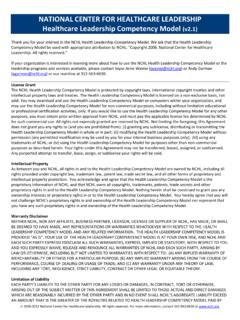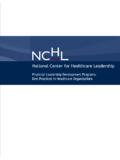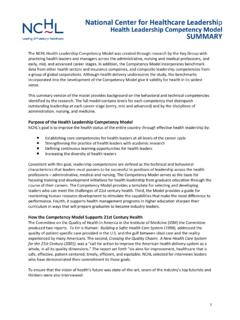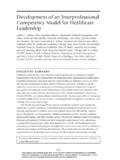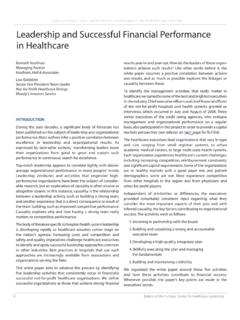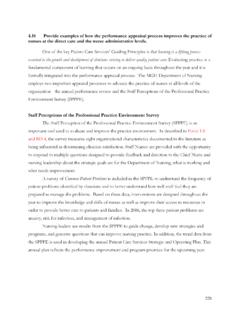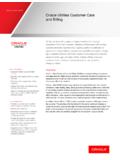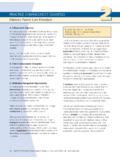Transcription of Best Practices in Health Leadership Talent …
1 NATIONAL CENTER FOR HEALTHCARE LEADERSHIPBest Practices in Health Leadership Talent Managementand Succession Planning:Case StudiesCopyright 2010 National Center of Healthcare Leadership . All rights reserved. No part of this publication may be reproduced or transmitted in any form or by any means, electronic or mechanical, including photocopy, recording, or any information storage and retrieval system, without written Center for Healthcare LeadershipBest Practices in Health Leadership Talent management and Succession Planning: Case StudiesTABLE OF CONTENTSI ntroduction1 North-Shore LIJ Health System 3 Virtua10 Moses Cone Health System18 Strong Leadership is likely the single most important driver ofoverall organizational performance, and well-constructed Talent management and succession planning systems remaincritical to developing and retaining a deep bench of strongleaders. Nowhere is the need for effective Talent managementand succession planning more pronounced than in the dynamic,complex healthcare industry, where leaders face unprecedentedpressure to transform their organizations so as to meet growingdemands for high quality, cost-effective care.
2 In fact, to meetthe ambitious expectations of Health reform (to reduce costsand simultaneously assure high quality) and to meet the goalslaid out by the Institute of Medicine that is, to deliver safe,effective, patient-centered, timely, efficient, and equitable carei the industry needs to better prepare and retain men andwomen to manage the complex organizations that provideand finance industry leaders understand the need to invest in talentmanagement and succession planning. A 2007 survey of humanresource managers in major corporations across multipleindustries identified Leadership development and successionplanning as the most important priorities for improvement,with 36 percent of respondents rating them as their top areasof focus going Some major corporations dedicatevery large sums of money to these tasks General Electric (GE),for example, spends roughly $1 billion a year on training, withleadership development representing one of three areas withinGE Global Learning (GE s umbrella approach to corporatelearning.)
3 Iv That said, a recent McKinsey survey suggests thateven though corporate leaders understand the importance oftalent management and succession planning, many do notadequately invest in them. For example, while respondentsgenerally believe that Leadership skills represent the singlemost important factor driving overall organizational performance,only 35 percent focus on developing such skills, and only 36 percent believe that their organization outperforms thecompetition in Leadership development. In addition, whilenearly 60 percent say that building organizational capabilitiessuch as Talent management represents a top-three priority,only a third of companies actually focus their training programson building these need for Talent management and succession planning maybe even greater in the healthcare industry, which faces shortagesin all types of leaders (administrative, physician, and nursing),high turnover among leaders (driven in part by a large numberof impending retirements) and front-line staff, and growing difficulties in attracting management Talent from other fact, many healthcare organizations are experiencing a crisisin their Leadership pipelines, with 18 percent turnover amongchief executive officers in 2009 (up significantly from previousyears)vii and significant turnover among chief nursing officers(CNOs) as well.
4 In fact, 25 percent of current CNOs have left asimilar position in the past five years and 62 percent plan to do so in the next High CNO turnover may also beresponsible for significant turnover among front-line nurses,with more than a quarter of new nurse graduates leaving theirfirst job within two High turnover causes significantcost and quality problems for an organization. For example, thefinancial cost of losing a nurse is roughly double the annualsalary for that addition, high levels of nurse turnovermay have a negative impact on quality and the patient experi-ence, as those new to the profession or a particular organiza-tion may be more prone to mistakes and/or otherwise not pro-vide the same level of care as does a more experienced turnover and an inadequate Leadership pipeline stem inlarge part from the systematic failure of healthcare organizationsto provide these leaders and those with the capabilities to replacethem with the support needed to develop professionally andperform their jobs effectively.
5 The National Center forHealthcare Leadership (NCHL) recently conducted a survey(the NCHL National Healthcare Leadership Index) and interviewson this topic, finding that not nearly enough attention is currently being paid to succession planning or Talent manage-ment activities, particularly (but by no means exclusively) fornurse leaders. To address this issue, healthcare organizationsneed to put in place a series of best Practices related to successionplanning and Talent management throughout the best Practices , taken from both insideand outside of healthcare, emphasize the following:xii Clear communication that stresses the importance of succession planning and Talent management as key organizational priorities and processes. Tight linkages between succession planning/ Talent management and the organization s overall strategy, priorities, and projected needs.
6 Extensive involvement of and ownership of the program by various levels of senior management , so as to help overcome organizational barriers to the career advancement of future leaders. Integrated use of a Leadership competency model, with competencies tied to organ-izational strategies and Center for Healthcare LeadershipIntroduction Recruitment of new employees targeted at those who sharethe organization s values and have the potential to developdesired competencies. Rigorous and repeated assessment of those with strongleadership potential, combined with aggressive efforts toretain them. Stretch job assignments for high-potential individualsdesigned explicitly to create new skills and perspectives. Highly customized and flexible professional developmentplans emphasizing on-the-job experience, supplemented byother forms of development.
7 Tight linkages between succession planning, candidateassessment, and development planning for future leaders. Ongoing measurement and evaluation of the outcomesderived from Talent management and succession planningactivities, with modifications based on what the organizationlearns so as to stimulate continuous report includes three case studies from healthcare organi-zations that have employed many of these best Practices as part of an effort to improve Talent management and succession planning processes. A very brief introduction toeach appears below: North Shore-LIJ Health System (NSLIJ), the second-largestnon-profit secular Health -care provider in the nation and thelargest integrated healthcare system in New York State,demonstrated how the best Practices can improve employeesatisfaction, significantly reduce turnover rates and associatedcosts, and improve overall financial performance.
8 Theseefforts led to NSLIJ receiving the Taleo Customer InnovationAward in 2009 in recognition of the initiative s contributionto improved financial Health . Virtua, a multi-hospital healthcare system headquartered inMarlton, NJ, developed a best practice Talent managementsystem that improves employee engagement and retentionof top Talent , creates a deep bench of potential leaders,achieves strong financial performance (moving from a nega-tive operating margin to top-tier performance in the state),and attracts external recognition for high-quality care. Moses Cone Health System, a five-hospital system in North Carolina, employed best Practices to improve performance on multiple outcomes related to nursing Leadership , including filling such positions quickly with inter-nal (rather than outside) Talent , deepening the bench of tal-ented nursing leaders, and virtually eliminating the loss ofnurses with strong Leadership potential.
9 Because of this success, the program has been expanded beyondnursing to incorporate all 600 clinical and administrativeleaders at Moses Cone. REFERENCESiCommittee on Quality, Institute of Medicine. Crossing the Quality Chasm: A New Health System for the 21st Century. Washington, DC: National AcademyPress, GL, Griffith JR. Ensuring management Excellence in the Health CareSystem. Journal of Health Administration Education Special Issue. 2001; Bersin & Associates. Enterprise Learning and Talent management 2007. Jan How GE Builds Global Leaders: A Conversation with Chief Learning OfficerSusan Peters. Knowledge@Wharton, May 12, 2010. Available at: Global Survey Results: Building organizational capacities. McKinseyQuarterly. Mar Ogden G, Talent management in a Time of Cost management . HealthcareFinancial management . Mar 2010; 64(3) CEO Turnover 1982-2009. American College of Healthcare Executives:Chicago, IL. Mar Jones CB, Havens DS, Thompson, PA.
10 Chief Nursing Officer Retention andTurnover: A Crisis Brewing? Results of a National Survey. Journal of HealthcareManagement. Mar/Apr 2008; 53(2) Kovner CT, Brewer, CS. Newly Licensed Registered Nurses Study. Robert WoodJohnson Foundation, BL, Cohen J, Gorenberg B. Nurse retention: is it worth it? NursingEconomics. Nov-Dec 2003; 21(6):262-8, 299, Jones, et al. Practices in Health Leadership Talent management & Succession Center for Healthcare Leadership : Chicago, IL. Apr Center for Healthcare LeadershipWHO THEY ARE: BRIEF OVERIVEW Founded in 1997, North Shore-LIJ Health System (NSLIJ) serves7 million residents of Long Island, Manhattan, Staten Island, andQueens. With revenues of roughly $6 billion and a workforce ofmore than 42,000 employees (making it the ninth largestemployer in New York City), NSLIJ is the second-largest non-profit secular healthcare provider in the nation, the largest integrated healthcare system in New York State, and the largesthealthcare provider in its region.
